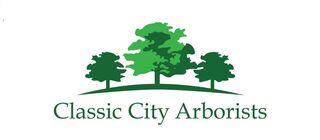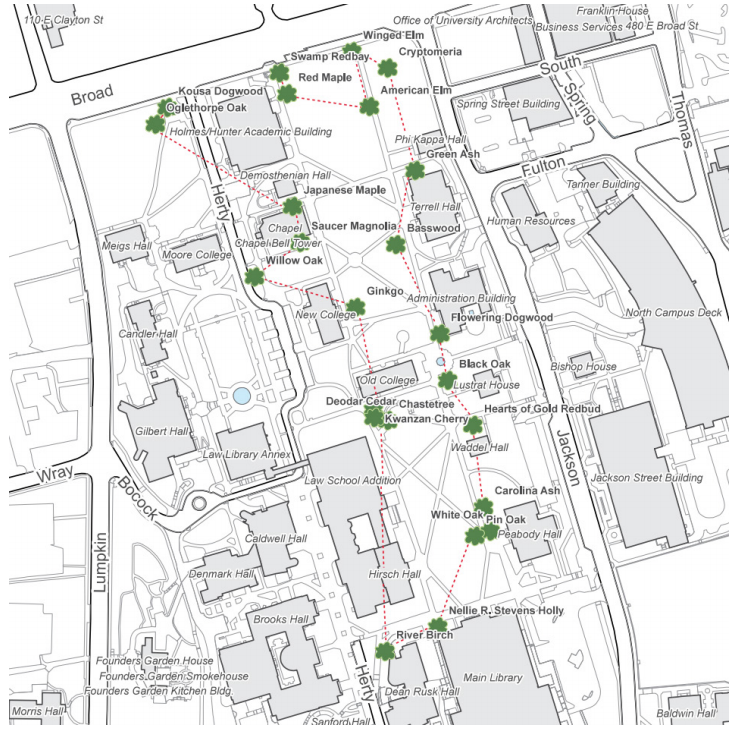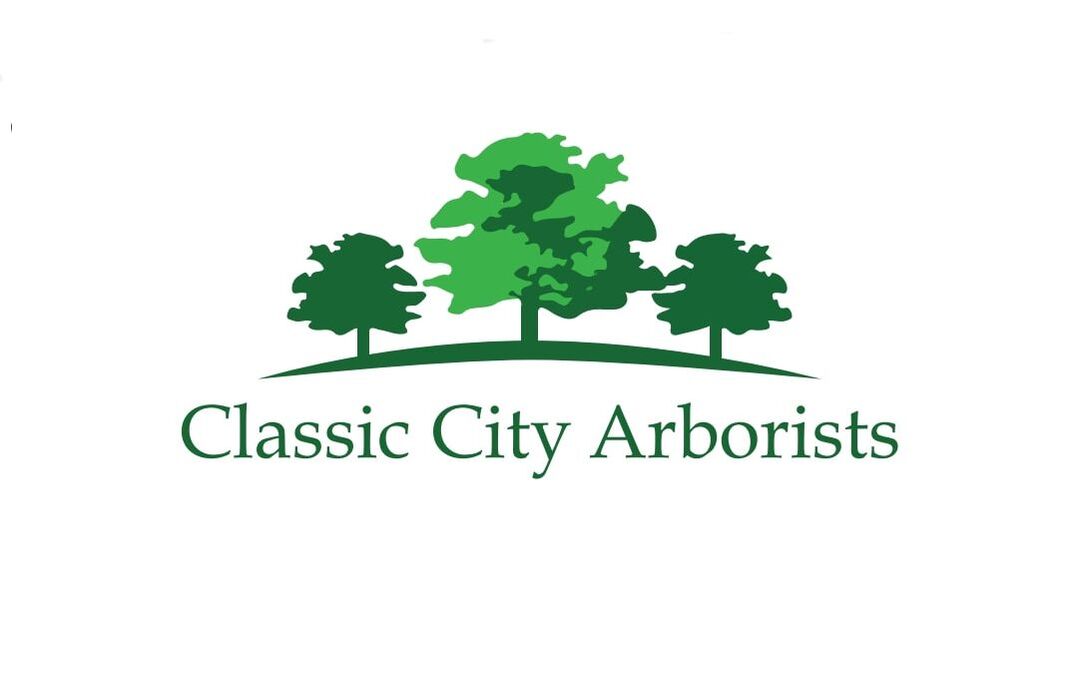|
News and Blog Articles
|
|
Last week, we talked about the UGA Campus Arboretum. An arboretum is a botanical garden that predominantly features trees. The UGA Campus Arboretum, as the name suggests, includes the entire UGA campus. Basically, all the trees and plants on campus are part of the Arboretum! There are certain trees that receive a little special treatment, however. Trees of historic, local, and botanical value, as well as a few stately specimens are identified with small black plaques that denote their species with the UGA Campus Arboretum logo. If you’re looking to seek out these special trees, you can do so by following one of the many Arboretum tours. This week, we’ll be going through the North Campus Tour, which features 24 trees. North Campus is the most historic section of UGA’s campus, and includes landmarks such as The Arch and the Holmes-Hunter Academic Building. To start, here’s what the route looks like: You can visit these trees in any order you want, really, but here’s the Arboretum’s suggestion: 1. Red Bay - Persea palustrisThe first stop on this tour is a large, multi-trunked Red Bay located just behind and to the left of The Arch (facing towards campus and the Holmes-Hunter Academic Building). This Red Bay was planted here specifically to commemorate the Ancient Egyptian tradition of planting persea trees at the entrance of their educational institutions. The Arch represents the entrance to the University, and so, Persea palustris was planted. 2. Red Maple - Acer rubrumKnown for their brilliant fall foliage, Red Maples are one of the most common hardwoods in North America. Check out our Tree of the Month article to learn more about Red Maples! 3. American Elm - Ulmus americanaAmerican Elms were once used as “meeting trees” to designate gathering spots by the Native Americans, and then later by the Sons of Liberty in the American Revolution. 4. Winged Elm - Ulmus alataWinged Elms get their name from the cork-like “wings” that form along branchlets. 5. Cryptomeria - Cryptomeria japonicaThis large evergreen conifer is viewed as sacred and often planted around temples and shrines in its native Japan, where it is the national tree. 6. Green Ash - Fraxinus pennsylvanicaThis native species is the most widely distributed across North America, and its high volume of seeds every year are an important food source for local wildlife. 7. American Basswood - Tilia americanaThe American Basswood is especially popular with bees, and lends a distinctive flavor to honey produced from its flowers, called basswood honey. 8. Flowering Dogwood - Cornus floridaA “four-season” tree, the Flowering Dogwood is known for its spectacular pink and white flowers in spring, its bright red berries in the fall, followed by a brilliant red fall foliage display. The mottled bark is also attractive when the tree is bare during winter months. 9. Black Oak - Quercus veluntinaThe common Black Oak prefers to grow on slopes, making it a good choice for erosion prevention. This particular tree grows the largest leaves of any oak on UGA’s campus! 10. Hearts of Gold Redbud - Cercis canadensisWith its pretty pink flowers and smaller stature, this decorative tree is a perfect addition to any landscape. The Hearts of Gold Redbud is also the state tree of Oklahoma. 11. White Oak - Quercus albaWhite Oaks are another wide-spread species in the eastern US, and are known for their hardiness against a range of climates and even wildfires. Check out our Tree of the Month article to learn more about White Oaks! 12. Pin Oak - Quercus palustrisThe branches of the Pin Oak are often described as pin-like, which is where this native, flood-tolerant species gets its name. 13. Nellie R. Stevens Holly - Ilex x 'Nellie R. Stevens'This hybrid species is named after Nellie Robinson Stevens, who pilfered a few pollinated English holly berries, only to have bees cross-pollinate them with a Chinese holly in a chance encounter that created an entirely new species! Check out our Tree of the Month article to learn more about Nellie R Stevens Hollies! 14. River Birch - Betula nigraRiver Birches are characterized by their “exfoliating” bark, which peels off in delicate, papery curls and leaves behind a mottled color pattern. Check out our Tree of the Month article to learn more about River Birches! 15. Chaste Tree - Vitex agnus-castusNative to Mediterranean regions of Europe and Asia, this ornamental tree features delicate foliage and lilac summer flowers that are especially attractive to butterflies. 16. Deodar Cedar - Cedrus deodaraNicknamed “the wood of the gods,” the Deodar Cedar is the national tree of Pakistan, and is native to the Himalayas and northern Africa, where it is considered sacred and often worshipped. 17. Kwanzan Cherry - Prunus serrulataA cultivar of the ornamental cherry tree, the Kwanzan Cherry was gifted to the United States by Japan in 1912. It gained popularity after being displayed at Washington DC’s annual Cherry Blossom Festival. 18. Ginkgo - Ginkgo bilobaThe Ginkgo, also known as the “fossil tree,” is the sole survivor of the Ginkgo genus. 19. Willow Oak - Quercus phellosThanks to their adaptability, Willow Oaks are a popular choice for landscapers and homeowners alike. Check out our Tree of the Month article to learn more about Willow Oaks! 20. Saucer Magnolia - Magnolia x soulangeanaA cross between Magnolia denudate and Magnolia liliiflora, the Saucer Magnolia is one of the most important magnolias in horticulture. These valued ornamental trees are loved for their large pinkish-white blooms with vibrant pink and purple stripes on their underside. 21. Japanese Maple - Acer palmatumJapanese Maples have a range of natural genetic divergences, and have also been cultivated into many different cultivars, leading to a wide array of distinct variations. 22. Robert Toombs OakThis stop doesn’t actually include a tree. Instead, it features a plaque that details the legend of the Robert Toombs Oak. In 1828, Robert Toombs gave a speech under a great oak tree. The speech was so eloquent and powerful that the entire commencement audience came out of the Chapel to listen. Upon the hour of his death years later, the same oak was supposedly struck by lightning. The charred remains of that tree are what is now called Toombs Oak. 23. Oglethorpe Oak - Quercus oglethorpensisThe Oglethorpe Oak is a rare species, currently classified as endangered, that was discovered in Oglethorpe County. Its name is meant to honor both the county and James Oglethorpe himself, the man who founded Georgia. 24. Kousa Dogwood - Cornus kousaNative to Japan, Korea, and China, the Kousa Dogwood is very similar to the US-native Flowering Dogwoods. It can be identified by the more pointed petals and attractive exfoliating bark. There you have it! The North Campus Tour. Stay tuned next week as we go through everything the Central Campus Tour has to offer! AuthorEmily Casuccio is sister and sister-in-law to Rebekah and Scott Rushing, and has over half a decade of experience in copywriting, copyediting, proofreading, and developmental storyboarding. She's worked with both published and undiscovered authors on both fiction and nonfiction, and takes pride in supporting local businesses. Her passion lies in the written word and helping authors of all capacities realize their dreams and achieve their fullest potential. To learn more about her, read samples of her work, or contact her, visit her online portfolio.
0 Comments
Your comment will be posted after it is approved.
Leave a Reply. |
Categories
All
Archives
January 2023
|
|
23 Whatever you do, work at it with all your heart, as working for the Lord, not for human masters,
24 since you know that you will receive an inheritance from the Lord as a reward. It is the Lord Christ you are serving.
Colossians 3:23-24
24 since you know that you will receive an inheritance from the Lord as a reward. It is the Lord Christ you are serving.
Colossians 3:23-24


